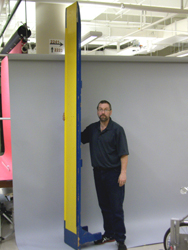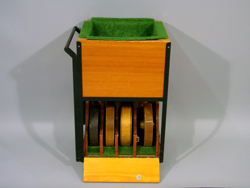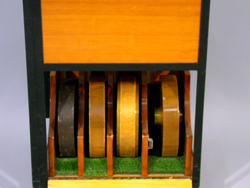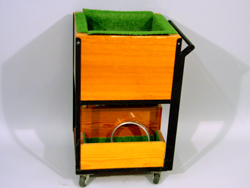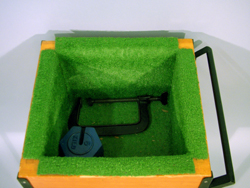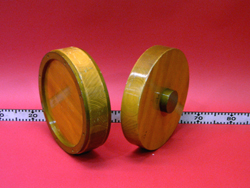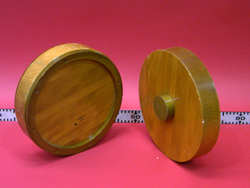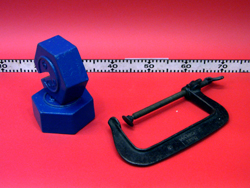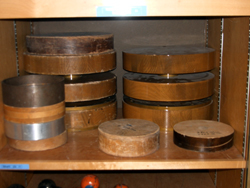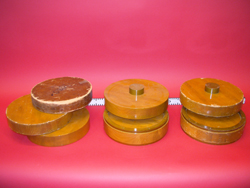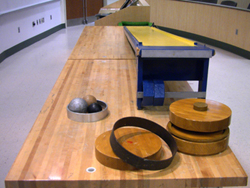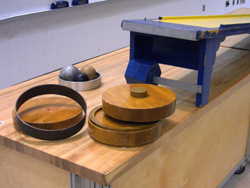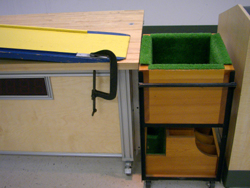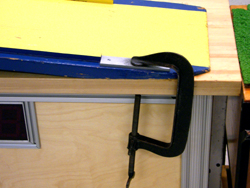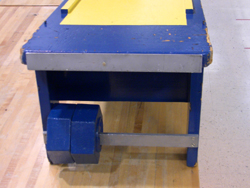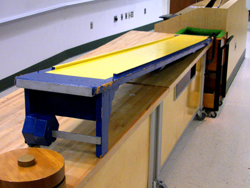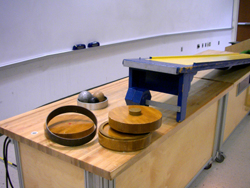Racing Disks, 1Q10.40
Topic and Concept:
Rotational Dynamics, 1Q10. Moment of Inertia
Location:
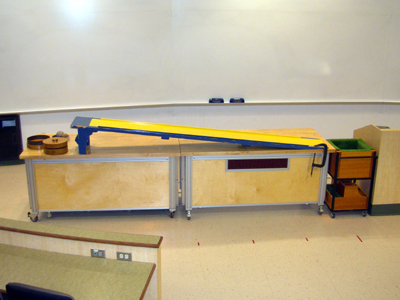
Abstract:
A ring, disc, sphere, and weighted discs of the same diameter are rolled down an incline. Each object reaches the bottom at different times due to differing moments of inertia.
Equipment |
Location |
ID Number |
|
|
|
Cart w/ Discs |
|
|
Inclined Plane |
|
|
Disc Extras |
ME, Bay B9, Shelf #3 or in Cart |
|
Important Setup Notes:
- N/A
Setup and Procedure:
Unload the discs from the cart. Note that the cart contains extraneous equipment for another demo 1Q10.30.
- Position the cart at the stage right end of the lecture bench so that it is touching the bench (see pictures).
- Place the ramp on top of the lecture bench so that it is in line with the cart and such that the bottom edge of the ramp is within about 2 inches of the cart.
- Secure the bottom of the ramp to the bench using the C-clamp provided in the cart.
- Use the provided weights to hold down the top end of the bench (see pictures).
- Roll down one disc with weighting in the center and then another with the weighting on the outer rim. The two can also be rolled down together for direct comparison. A stop watch can be used to quantitatively measure the times.
Cautions, Warnings, or Safety Concerns:
- N/A
Discussion: For a system of N particles, the moment of inertia can be defined as I = Σimi*ri2 where i ranges from 1 to N. This is important when considering the rotational dynamics of a system. In our case, we are dealing with rigid bodies and can consider the mass distribution to be continuous and uniform in each object consisting of one material. In this case we can replace the discrete sum with an integral over the volume of the object: I = ρ*∫ r2 dV. Since there is another type of material (the weighting), we need to do this calculation for the disc and the weighting. Itotal = Idisc+Iweighting This quantity is analogous to mass in translational motion. In our case, the moments of inertia for these objects are
Disc: I = (1/2)*M*R2
Hoop: I = M*R2
where M is the total mass, R is the radius, and the axes of rotation is taken to be the axis of rotational symmetry. Each disc begins to roll down the ramp (i.e. attains an angular acceleration) because there is a net torque on the objects, the acceleration being determined by α = τnet/I. This shows us that the greater the moment of inertia of an object, the smaller its angular acceleration will be. This is why each object reaches the bottom of the ramp at different times.
Since the mass of each disk is the same, the disc with the mass more concentrated toward its center (i.e. the disc with the weighting in the center) will roll faster than will the disc with the weighting on the outer rim (further from the axis of rotation).
|
|
|
|
|
|
|
|
|
|
|
|
|
|
|
|
|
|
|
Videos:
References:
